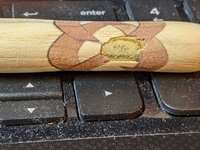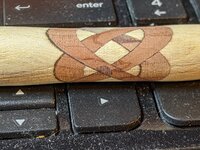jwhiting
Member
Hello - I'm a new pen turner, trying my first Celtic knots. I'm sorry if I'm posting incorrectly (wrong thread, etc.). This is my second knot (second fail, too), and I'm seeking diagnostic help. In both pens I ran out of blank and reached the tube before the knot "joined". The attached two pics are of the same blank, and show one side where the knot joined and the opposite side where it did not. My guess is that the tube is not exactly centered in the blank or perhaps the blank was not exactly square. Can anyone confirm either guess or offer another explanation?


